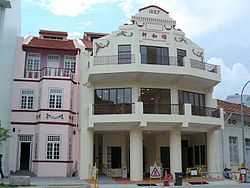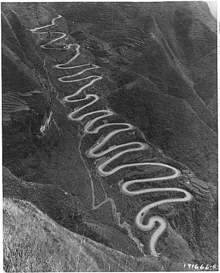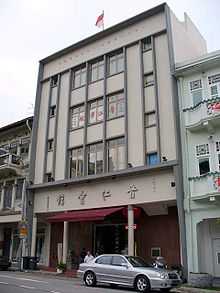Ee Hoe Hean Club

The Ee Hoe Hean Club (simplified Chinese: 怡和轩俱乐部; traditional Chinese: 怡和軒俱樂部; pinyin: Yíhéxuān jùlèbù), founded in 1895 and located at Bukit Pasoh Road in Chinatown, was a millionaires' club in Singapore. Besides functioning as a social and business club, members of the club were actively involved in the political development of China in the early 20th century. The club supported the 1911 Xinhai Revolution which overthrew the Qing Dynasty, and later the establishment of the Republic of China. During World War II, it was the headquarters of the anti-Japanese China Salvation Movement in Southeast Asia from 1937—1942. On 18 October 1995, the club was gazetted as a Heritage Site by the National Heritage Board of Singapore.[1]
History
Co-founded in 1895 by Lim Nee Soon, Gan Eng Seng and Lim Boon Keng,[2] the three-storey high Ee Hoe Hean Club was originally located on Duxton Hill but moved to Bukit Pasoh Road in 1925. The club was a social-cum-business club where like-minded Chinese businessmen could mingle and exchange ideas. Members such as Teo Eng Hock, Tan Chor Nam and Lim Nee Soon were actively involved in the Xinhai Revolution and later the establishment of the Republic of China.[1] Among the more famous visitors to its clubhouse included Sun Yat-sen and Jawaharlal Nehru.[3] In 1923, when Chinese businessman, community leader and philanthropist Tan Kah Kee, known as the Rubber King of Singapore and Malaya, assumed chairmanship of the club, its focus shifted from being a purely social and business club to one that was politically active.
Tan Kah Kee
Born in 1874 in Fujian, China, Tan came to Singapore at the age of 16 to join his father's business. In 1904, Tan struck out on his own, selling pineapples and rice and manufacturing rubber tyres and shoes. Tan's rubber business flourished and, with growing wealth, he altruistically donated money to many schools and established Amoy University (now Xiamen University). However, Tan's loyalty still lay with his motherland and he ardently supported opponents of the Qing rulers during the Xinhai Revolution. By this time, Tan's philanthropic work and political inclinations had made him a popular figure amongst the Chinese in Singapore and China.[4]
Tan brought to the club his political awareness of Chinese matters. In 1928, following a public outrage over a massacre at Jinan (known as the Jinan Incident) in Shandong in which more than 5,000 Chinese soldiers and civilians were slaughtered by the Japanese,[5] the club set up the Shandong Relief Fund. Its purpose was to raise funds for China, to create awareness amongst the Chinese about the Japanese invasion of China, and to encourage the Chinese to boycott Japanese goods and services. The Chinese community contributed a total of S$1.34 million within a year of its inception.[4]
Seeing that the Chinese military was weaker than the superior Japanese forces, Tan stepped up his anti-Japanese campaign. In 1936, he raised enough money for the Chinese Air Force to purchase 13 fighter planes.[4] In 1937, the Chinese Relief Fund Committee was set up with Tan chosen by over 800 representatives of the Chinese community as its chairman. In response to the Japanese invasion of China in 1937, the China Salvation Movement was born, with its Southeast Asian headquarters located at the club until 1942, when the Japanese invaded Singapore.[4] Tan fled to Indonesia just a few days before the fall of Singapore as he knew he would likely face persecution by the Japanese should he choose to remain. He returned to Singapore after the war and continued to play an active role in community services and charity work before returning to China in 1950. He died at the age of 87 in Beijing on 12 August 1961 and was accorded a national funeral by the People's Republic of China government for his various contributions to society.[6]
Recruitment of drivers and mechanics

During the Second Sino-Japanese War, many Chinese seaports were either captured or blockaded by the Japanese, in an attempt to prevent supplies from entering China.[7] As a result, an alternative overland road named Burma Road, became China's most important supply route. Completed in 1938, supplies were sent by sea to the port in Rangoon, Burma, transported overland by rail to Lashio and through the Burma Road to Kunming in China. Due to lack of experienced drivers and mechanics in China, the Chinese government requested Tan Kah Kee, the Chairman of the China Relief Fund, to recruit volunteers from Nanyang (a term used by the Chinese when referring to Southeast Asia). Following the request, the China Relief Fund published the first recruitment notice on 7 February 1939.[8]
As the road condition required extremely good driving skills, the China Relief Fund decided to test drivers and established a driving institute on a vacant piece of accessible land behind the Siong Lim Temple.[7] Venerable Pu Liang, the monastery's 10th abbot, supported the China Relief Fund. Qualified volunteers from Nanyang converged in Singapore to form a batch. In 1939, about 3,200 volunteers left in nine batches that included only Chinese men but also Indians, Malays, and four Chinese women.[9] About 1,000 of them died in service, 1,000 settled in China and others returned to Nanyang after the war.[9] The Venerable and two of his disciples were later arrested and executed during the Sook Ching Massacre in 1942.[10]
Recruitment of militia

Located just a stone's throw away lies another historic site, the Chin Kang Huay Kuan, a Chinese clan association that was established in 1918 by Chinese immigrants from Jinjiang County in southern Fujian, China. The present building on Bukit Pasoh Road was built in 1928 and its wartime history was intricately linked to Ee Hoe Hean Club. During the Japanese invasion of Singapore, the clan association's premises served as an extension of the club's anti-Japanese activities and were used by the Overseas Chinese General Mobilisation Council. Headed by Tan Kah Kee, the council was instrumental in helping the British to maintain law and order and in supplying labourers and volunteers for the defence of Singapore.[11] As a result, it became the recruiting centre and headquarters of the Singapore Overseas Chinese Volunteer Army or Dalforce after its British chief commander, Colonel John Dalley. A surviving volunteer named Hu Tiejun recounted his experience:
I came across an article in the papers in which Mr Tan Kah Kee called for a convention of overseas Chinese on behalf of the Governor of Singapore. The purpose of the convention was to set up a Singapore Overseas Chinese Mobilisation Association composed of a defence squad, local militia and labour team. The same day after reading it, I set off to Singapore. On 2 February 1942, I led some members of the local militia to the Volunteer Army headquarters. During this time, many patriotic young men who were untrained in military skills, streamed into Singapore.[12]
Although ill-equipped and having received little training, Dalforce was sent to the northwestern front where they fought against Japanese landing parties during the battles of Sarimbun Beach and Kranji. Despite their efforts, Singapore fell to the Japanese a few days after the invasion, and the Japanese army moved in to occupy the Chin Kang Huay Kuan. After the Japanese surrender on September 1945, Chin Kang Huay Kuan resumed its normal activities of running welfare programmes for needy clan members and organising cultural events.[11]
Post-war years
After the Japanese occupation of Singapore, the club's anti-Japanese agenda became redundant and it reverted being a club for social and business interaction once again. Its members were later active in the struggle for citizenship, voters' registration campaign and other philanthropic activities. After Singapore's independence in 1965, it became a focal point where local Chinese businessmen socialised and forged ties, and it continued to play an active role in community services such as charity work and giving public talks.[1] Among its 200-odd members today are luminaries of the Chinese business community such as the founder of the Overseas Union Bank, Lien Ying Chow, and United Overseas Bank chairman Wee Cho Yaw. It is still an all men's club – the youngest members are mainly in their 50s and membership is by invitation only.[13]
Re-opening
In 2006, in collaboration with the Tan Kah Kee Foundation, the club underwent a S$2.5 million (US$1.85 million) reconstruction works in order to preserve the century-old historic building.[14] On 9 November 2008, the club was officially reopened by Finance Minister Tharman Shanmugaratnam with a new 2,000-square-foot (190 m2) memorial hall to honour Tan Kah Kee and other early Chinese community leaders.[15] The new hall is named Xian Xian Guan (The Pioneers' Memorial Hall) and is located on the club's ground floor. It contains exhibits such as a wax figure of Tan Kah Kee, old photographs, and interactive multimedia facilities. The second floor is used for social functions, and the third floor continues to house the social club. The memorial hall is open by appointment to the public, in particular to schools and tourist groups from China and Taiwan.[15] The club house and other places related to Tan are included as part of the heritage trails and guided tours around Singapore.[14]
See also
Notes
- ↑ 1.0 1.1 1.2 Information obtained from on-site plaque installed by the National Heritage Board of Singapore.
- ↑ Cornelius-Takahama, Vernon. "Lim Nee Soon". National Library Board Singapore. Archived from the original on 2007-07-05. Retrieved 2007-08-28.
- ↑ "Club 'Nerve Centre Of Reform'". The Straits Times. 5 October 1995.
- ↑ 4.0 4.1 4.2 4.3 Uma, "Ee Hoe Hean Club", pp. 68—69.
- ↑ Foong, "The Singapore Overseas Chinese Salvation Movement", p. 217.
- ↑ "Tan Kah Kee Biography". Tan Kah Kee International Society. Retrieved 2007-04-15.
- ↑ 7.0 7.1 Chan, "Drivers and Mechanics From Nanyang", pp. 5—6.
- ↑ Sin Chew Jit Poh (in Chinese), 8 February 1939, p.9.
- ↑ 9.0 9.1 Chan, "On To The Burma Road", p. 5.
- ↑ Chan, "The Sook Ching Massacre", p. 6.
- ↑ 11.0 11.1 Uma, "Chin Kang Huay Kuan", p. 69.
- ↑ Foong, "We Fought at the Frontline Defending Singapore", p 274.
- ↑ Chia, Sue-Ann (26 October 2003). "Young towkays wanted - to share sweet potato porridge". The Straits Times.
- ↑ 14.0 14.1 Leong, Weng Kam (17 July 2008). "Hall to honour Chinese pioneers". The Straits Times. p. H5.
- ↑ 15.0 15.1 Luo, Serene (10 November 2008). "'Hall of fame' for pioneers of finance". The Straits Times. p. B7.
Bibliography
- Foong, Choon Han (1997). The Price of Peace—True Accounts of the Japanese Occupation. Singapore: Asiapac Books. ISBN 981-3068-53-1.
- G. Uma, Devi (2002). Singapore 100's Historic Places. Singapore: National Heritage Board. ISBN 981-4068-23-3.
- Chan, Chow Wah (April 2007). "Storm in Shuang Lin". Biblioasia 3 (1).
- Lee Kong Chian Reference Library, Singapore.
- National Heritage Board, Singapore.
Coordinates: 01°16′46.45″N 103°50′25.07″E / 1.2795694°N 103.8402972°E